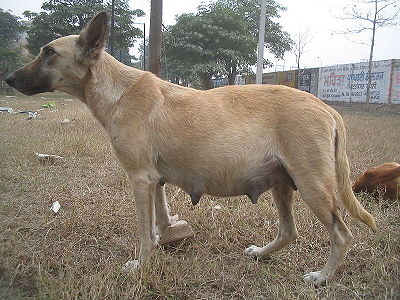
Dog Mammory Cancer
Veterinarian Reviewed on November 23, 2012 by Dr. Janice Huntingford
Dog Mammary Cancer
The easiest Dog Cancer to prevent in female dogs is mammary cancer. The risk is negligible in non-breeding females that have undergone Dog Sterilization, or spaying, before their first heat. This tumor can be large or small. It can appear as a simple nodule or as an aggressive growth. Most of the tumors can be treated successfully with an early diagnosis.
Most commonly, non-spayed middle-aged female dogs are the most afflicted. This would be between 5 and 10 years of age. It is extremely rare in dogs that have been spayed before their initial heat. As age increases before spaying, so too does the instance of the disease.
The percentage of dogs being spayed before and after first heat rises from .05% to 8%. This is a significant increase that can easily be prevented. Veterinary science feels that the reduction in production of certain hormones reduces the risk of mammary cancer in dogs that have been spayed.
The types of mammary cancers are numerous. Almost one half of all mammary tumors are benign. All should be identified through biopsy when it is first noticed. Do not adopt a ‘wait and see’ attitude. Noticing a new lump in the mammary area, is reason enough to check with your vet immediately. Male dogs can also get mammary cancer and it is more aggressive in the males, although not as common.
Signs and Symptoms
Symptoms are easy to recognize. There will be either a single solid mass or several areas of swelling. A gentle touch in the area of the mammary glands will identify any new lumps. In the beginning it feels like little pieces of gravel. They will be right under the skin and will be easy to detect. You will also notice that they do not move very much and will grow quite rapidly.
Mammary cancer can, and does, spread to the rest of the dog’s body via their lymphatic system. Once these axillary and inguinal lymph nodes are affected, the disease is much more difficult to treat. Early detection is therefore extremely important.
Treatment
The most successful treatment of mammary cancer is surgical removal of the tumor and/or the associated mammary gland. In over half of the cases the cancer can be removed if detected and treated early. In very old female dogs it is more difficult for them to survive the surgery.
Chemotherapy and radiation are being studied by veterinary scientists and have been proven to be very effective at this time. This again is a reason for early detection and treatment.
The adage “an ounce of prevention is worth a pound of cure” fits very well in this instance. If you check your dog regularly and report any changes to your vet, chances are good that recovery will be successful.
This common cancer can often be treated very successfully. It can also be almost eliminated if every non-breeding dog was spayed before their first heat. It is unfortunate that veterinarians have to deal with this easily preventable disease on such a regular basis. If a growth of any kind is found in the mammary area, report it to your vet immediately. Have your non-breeding female spayed at a young age. These are simple tips to prevent a potentially tragic illness in the long run.
Sign up for our newsletter and receive more articles and the latest pet health updates and special offers.
Our Expert
 Dr. Janice Huntingford
Dr. Janice HuntingfordJanice Huntingford, DVM, has been in veterinary practice for over 30 years and has founded two veterinary clinics since receiving her Doctor of Veterinary Medicine at the Ontario Veterinary College, University of Guelph. She has studied extensively in both conventional and holistic modalities. Ask Dr. Jan

